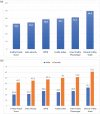Prevalence and correlates of frailty in older hypertensive outpatients according to different tools: the HYPER-FRAIL pilot study
- PMID: 37698894
- PMCID: PMC10713004
- DOI: 10.1097/HJH.0000000000003559
Prevalence and correlates of frailty in older hypertensive outpatients according to different tools: the HYPER-FRAIL pilot study
Abstract
Objectives: To date, few studies have investigated frailty in hypertensive individuals. This study aimed at identifying the prevalence of frailty in a sample of hypertensive older outpatients using six different identification tools. Clinical correlates of frailty and agreement between different frailty definitions were also investigated.
Methods: The HYPER-FRAIL pilot study recruited hypertensive patients aged at least 75 years from two geriatric outpatient clinics of Careggi Hospital, Florence, Italy. Four frailty scales [Fried Frailty Phenotype, Frailty Index, Clinical Frailty Scale (CFS), Frailty Postal Score] and two physical performance tests [Short Physical Performance Battery (SPPB) and usual gait speed] were applied. The Cohen's kappa coefficient was calculated to assess agreement between measures. Multiple logistic regression was used to identify clinical features independently associated with frailty.
Results: Among 121 participants (mean age 81, 60% women), frailty prevalence varied between 33 and 50% according to the tool used. Moderate agreement was observed between Fried Frailty Phenotype, Frailty Index and SPPB, and between Frailty Index and CFS. Agreement was minimal or weak between the remaining measures (K < 0.60). Use of walking aids and depressive symptoms were independently associated with frailty, regardless of the definition used. Frailty correlates also included dementia, disability and comorbidity burden, but not office and 24-h blood pressure values.
Conclusion: Frailty is highly prevalent among older hypertensive outpatients, but agreement between different frailty tools was moderate-to-weak. Longitudinal studies are needed to assess the prognostic role of different frailty tools and their clinical utility in the choice of antihypertensive treatment.
Copyright © 2023 The Author(s). Published by Wolters Kluwer Health, Inc.
Conflict of interest statement
The authors have no conflicts of interest to declare.
Figures



References
-
- Fried LP, Tangen CM, Walston J, Newman AB, Hirsch C, Gottdiener J, et al. . Frailty in older adults: evidence for a phenotype. J Gerontol A Biol Sci Med Sci 2001; 56:146–157. - PubMed
-
- Vermeiren S, Vella-Azzopardi R, Beckwée D, Habbig A-K, Scafoglieri A, Jansen B, et al. . Frailty and the prediction of negative health outcomes: a meta-analysis. J Am Med Dir Assoc 2016; 17:1163e1–1163e17. - PubMed
-
- Hoogendijk EO, Afilalo J, Ensrud KE, Kowal P, Onder G, Fried LP. Frailty: implications for clinical practice and public health. Lancet 2019; 394:1365–1375. - PubMed
Publication types
MeSH terms
LinkOut - more resources
Full Text Sources

